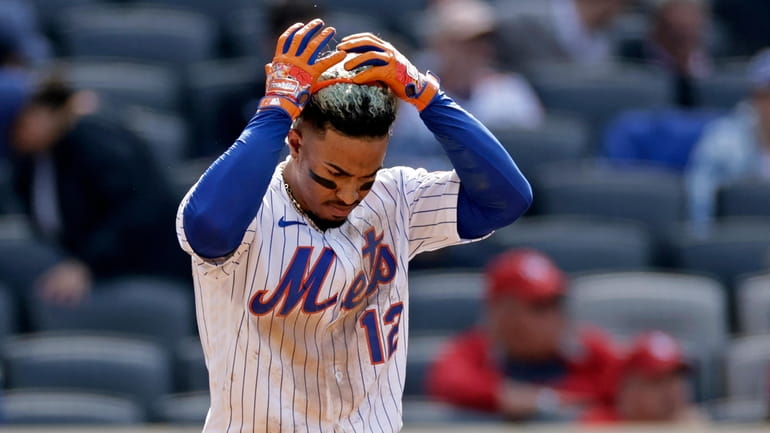Francisco Lindor's numbers can't be escaped: $341 million

Mets' Francisco Lindor reacts after striking out during the ninth inning of a baseball game against the St. Louis Cardinals on Thursday, May 19, 2022, in New York. Credit: AP/Adam Hunger
The biggest drawback to being a $341 million baseball player?
Having to perform like one.
Just look at what’s been going on with Francisco Lindor through the first 40 games this season, and really, since he signed that 10-year contract on the eve of Opening Day 2021.
Everything that Lindor does is viewed through the prism of that record-setting deal. It’s rare that his name appears anywhere without the dollar figure attached in some fashion. But what’s the formula to figure out if Steve Cohen is getting ripped off or not?
If you want to compare Lindor to the closest shortstop in his salary range, there’s Fernando Tatis Jr. ($340M), but he has yet to play for the Padres this season after suffering a broken wrist in an offseason motorcycle accident. Next up would be Corey Seager, who signed a 10-year deal worth $325 million with the Rangers last December.
Lindor is playing to a 1.3 WAR, according to FanGraphs, hitting .240 with six homers, 26 runs scored, 22 RBIs and a .743 OPS for the first-place Mets, who entered Saturday at 26-14 and led the NL East by 7 1/2 games before their doubleheader against the Rockies. Seager also has a 1.3 WAR, batting .245 with eight homers, 19 runs scored, 19 RBIs and a .752 OPS for the third-place Rangers, who entered Saturday at 18-20 and were 6 1/2 games out in the AL West (2 1/2 back in the wild-card race).
Based on the lofty expectations surrounding Lindor upon his arrival in Flushing, it doesn’t require any fancy algorithms to determine that he’s not living up to what people imagined. Not yet, anyway. Through his first 165 games in a Mets uniform, he was hitting .233 with 26 homers, 99 runs scored, 85 RBIs, 15 stolen bases and a .736 OPS. His 162-game averages during his six years in Cleveland: .285 average, 29 homers, 106 runs scored, 85 RBIs, 21 stolen bases and an .833 OPS.
On the subject of statistics, Lindor told reporters earlier this month in regard to snapping out of a slump: “You guys love talking about numbers. I hate talking about numbers.” Whether Lindor was being playful or not, he obviously knows this is a numbers game, a results-driven industry, and that $341 million might as well be stitched on the back of his jersey. It’s inescapable.
And with Lindor sweating some intensifying heat this past week, the Mets have gone out of their way to provide some cover. Buck Showalter offered a few unsolicited compliments about his shortstop during his media briefings and even had a yellow post-it note with a hand-picked selection of Lindor stats jotted down for reference (even though no one specifically asked).
The temperature got turned up on Lindor after the Mets split Tuesday’s doubleheader with the Cardinals, when he struck out to end the 4-3 loss in Game 2 with the tying run at second base. That capped a 1-for-7 night at the plate and dropped him to .161 (13-for-81) in 21 games since April 24, including only four extra-base hits (two doubles, two homers).
When Lindor was asked about that game-ending strikeout and how he was feeling in general from an offensive standpoint, he replied in part, “Pitchers have nice cars, too.” Some do, sure. But Max Scherzer is the only one at Lindor’s pay grade, and he doesn’t have to face him.
Lindor also didn’t sound thrilled to be singled out during the interrogation, but he’s got to know by now that comes with the $300 million territory. When Pete Alonso whiffed with the bases loaded to end Sunday’s 8-7 loss to the Mariners, failing to check his swing on a slider way out of the strike zone, he was surrounded by reporters soon afterward, asking for his perspective on that final at-bat. Alonso clearly was upset that he didn’t come through, but this is his fourth season in Flushing, and he knows the drill.
This is Lindor’s second year with the Mets but first in the post-Zoom Era, and the New York clubhouse experience often takes some adjustment, especially coming from a much smaller market like Cleveland. But it’s not a coincidence that the Mets put him in the corner locker (adjacent to the front door) formerly occupied by David Wright, the team’s last captain. That type of high-end real estate comes with responsibility — not only media-wise but as a visible team leader.
From the day he arrived in spring training, Lindor had been fine handling the PR side of his duties this year, whether it was talking about his prominent role in the labor negotiations or a fresh start after a subpar Mets debut. Mr. Smile seemed to be back with great aplomb.
But that gets more challenging when the on-field performance slides, and Lindor can never be just one of 26 guys. When he whiffs to kill a late rally, it won’t be just another strikeout even though such a thing happens routinely to every player in the course of a long season.
That may feel unfair, given the sport’s maddeningly high rate of failure. But once a player crosses that $300 million threshold, he rockets beyond the orbit of what’s considered normal baseball realities. Players who make that much money are judged differently, regardless of the measuring tool.
So when Lindor ranks 62nd in the majors in hitting .222 (8-for-36) with runners in scoring position — the Mets as a team are ninth overall (.269) — or he’s batting .091 (2-for-22) with seven strikeouts in high-leverage situations (according to baseball-reference.com), the spotlight shines brightest on him.
Throw in the fact that Andres Gimenez — one of the middle infielders the Mets sent to Cleveland in the 2021 trade — is hitting .310 with an .857 OPS through 32 games (at the low, low, low salary of $706,000), and Lindor comes off even worse.
Lindor should consider himself lucky that the Mets have been so successful despite his bumpy spring while the rest of the division has sputtered. That makes it easier for Showalter & Co. to emphasize Lindor’s baserunning skills and defensive ability as he struggles to keep pace with the top offensive performers in the Mets’ lineup.
“I don’t worry about him,” Showalter said this past week. “He’s playing a good shortstop. Playing with great effort. He’s engaged in every game, every inning. I’m real happy with him . . . He’s going to be a good, solid contributor for us all year long . . . What is happening may not be perfect statistically. He’ll figure it out.”
After Showalter's comments, Lindor reached base in a career-high eight straight plate appearances (four walks, three singles, one HBP) and scored five runs in the Mets’ two wins over the Cardinals. That was a glimpse into some of what people had envisioned from Lindor, but even during that small electric sample, he didn’t deliver a jolt like other members of the $300 million club such as Manny Machado or Bryce Harper or Giancarlo Stanton (we’ll stop short of introducing Mike Trout into this conversation).
It’s unrealistic to see Lindor having the same impact as those sluggers, but he’s in that exclusive club nonetheless. Cohen put him there, and now Lindor has to deal with all the pressure that comes with membership.
“I’ve got to do whatever it takes to keep on grinding, keep on working, keep my head down and leave the rest to God,” Lindor said this past week.
With the Mets suddenly losing Scherzer for up to two months, they’d be justified in turning to Lindor for an additional boost as the resident superstar. Or at least the guy they pay the most to get the job done. That’s what the money’s for.

